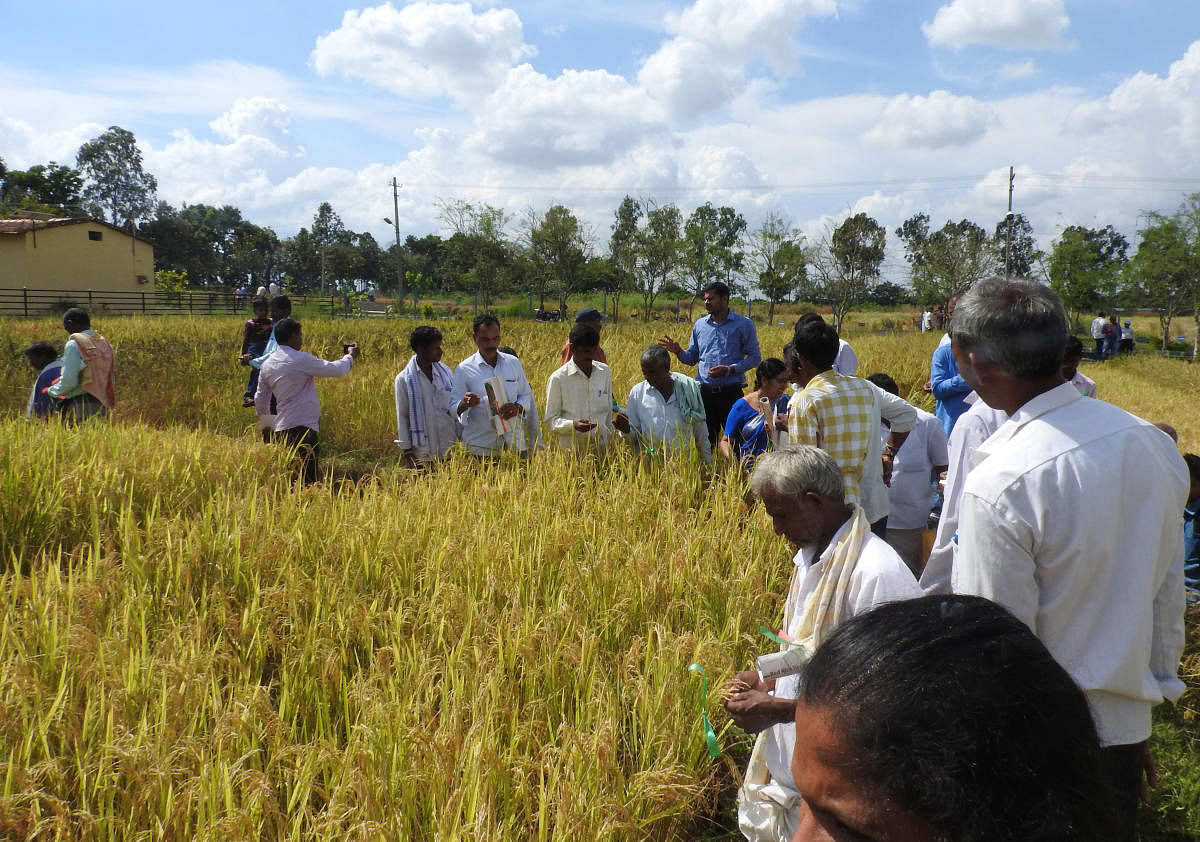
Recently, the Organic Farming Research Centre (OFRC) at the University of Agricultural and Horticultural Sciences, Shivamogga, was brimming with activities, reminding one of a festive season.
There were hundreds of farmers from across the state. They competed with each other to have a glimpse of paddy stacks of native varieties. The centre had set up 192 paddy stacks of various native varieties which included Rajamudi, Gandhasale, Rajabhoga, Chinnaponni, HMT, Ambemohar, Huggi Bhatta, Malgudi Sanna, Jeerige Sanna, Burma Black and Rathna Choodi.
Sustainable cultivation
One of the largest demonstrations of paddy stacks in Karnataka, the effort intended to popularise sustainable paddy cultivation among the farming community. The enthusiasm was such that each one of the farmers wanted to have the latest updates on those varieties.
A two-member expert team comprising associate researcher M Y Ullas and Dr S Pradeep, director, OFRC, conducted interactions with the farmers clarifying their doubts. The duo also provided inputs and perception.
Sarojamma, a farmer from Harihar, was surprised to see the varietal diversity. “I thought I was rich enough as I had 30 varieties of indigenous paddy. However, I am stunned to see these many varieties here,” she exclaimed. Shivaji Gouda Patil, a farmer from Hangal, was satisfied as he found a variety that suited the soil of his field, in these blocks.
After the Green Revolution in the early 1960s, the high-yielding paddy varieties hit the market, promising higher yields. There was more focus on the use of chemicals for higher yields. As a result, soil lost its fertility and local varieties disappeared from the fields.
It took a few decades for farmers to realise the consequences of the use of chemicals on the crops. As a result, they returned to organic farming gradually and, in turn, started growing local varieties. Unfortunately, many of these varieties were on the brink of extinction.
Farmers’ groups in the state and elsewhere in the country collected seeds of local varieties and engaged in their cultivation. Over the years, more farmers were drawn to local varieties and sustainable methods of farming.
While there are many individual efforts, several such efforts in Karnataka, Kerala, Tamil Nadu and West Bengal came together under the banner of Save Our Rice Campaign, with an aim to build a movement towards achieving food security and sovereignty, reviving our rice culture and sustaining rice eco-systems. The campaign which was launched in 2004, attempts to sustain rice by creating linkages between different sectors, building alternative models for sustainable ecological rice cultivation, developing capacities to address issues related to rice, and developing a platform of people with rice culture as a common concern. Both farmers’ organisations and individual farmers are a part of this network.
Field visits, tours, workshops and training programmes are organised to help understand the transitioning farmers understand seed selection and cultivation method.
The campaign has also been backed by Krishi Vigyan Kendras and other government-run agriculture research stations. Agricultural and Horticultural Research Station, Brahmavara and Organic Farming Research Station, Naganahalli, Mysuru have conducted workshops and demonstrations in this regard.
OFRC’s then-coordinator Dr N Devakumar had set up 70 stacks of native varieties for the demonstration eight years ago, which largely benefited farmers. Now the number of native varieties has reached 192. The centre is engaging farmers to preserve as many varieties as possible.
“The Green Revolution ensured food sufficiency in the country. It is high time we focused on quality,”
Dr Manjunatha K Naik, vice-chancellor, University of Agricultural and Horticultural Sciences, Shivamogga points out. “The university has taken an initiative to preserve local varieties,” he adds. Naik promises distribution of seeds at subsidised rates to farmers.
“Mostly, these local varieties are not affected by diseases. The cost of cultivation is also less,” Pradeep explains. The state has many varieties that are highly adaptable to changing weather conditions. The centre plans to create a database of every variety and analyse the nutritional values. However, preserving indigenous varieties of paddy isn’t just enough. There is a need to create a market for the produce.
“A few paddy growers’ associations have created the market for their produce. The government should focus on on-farm research, standardise sustainable paddy practices and implement sustainable farming techniques,” stresses G Krishna Prasad, a member of Save Rice Campaign. Those who are interested can contact
Ullas on 6361596337.
(Translated by Jagadish Angadi)
